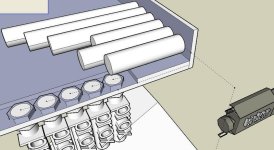The belt only needs to be about 18" long, with spacing blocks (separated by the diameter of the dowels) attached to create cleats or "slots" on the belt. The spacers should be semi-circular, so that a dowel falling onto the belt will roll into the nearest slot. You could make those by splitting some 1/2" wooden dowel rods in half with a band saw. Then hot-glue or sew them to the belt, so that only one dowel can fit into each slot on the belt. If your metal dowels are 1/2" diameter, then your slots can be about 1/2" wide. You might even find an abandoned piece of cleated belting that would work.
You could design a feed hopper with a slot that only allows one dowel to feed out into each slot on the belt. You could move the belt with a simple crank rod attached to the roller on one end. As you turn the crank by hand, the dowels should roll into a belt slot, get moved past the sensors, with the longest sensor first, down to the shortest sensor. At each sensor position, you will have a solenoid that (if that sensor is triggered) will pop out and kick the dowel down a chute on the opposite side. Make the chute wide enough to allow for small variations in the time when the kicker pops out. Because the dowel will be moving, each one will be sensed and popped off at a slightly different place. In other words allow for the tolerances of your system. Your discharge chutes probably will need to be at least 3 times wider than your dowel diameters. Your kicker solenoids need to be slightly downstream of the sensors. It takes some small time for the kicker to get moving and contact the dowel. Because the dowel is moving, you are shooting at a moving target and you must aim slightly past the point of detection in order to hit the target dead center, just like shooting at a running man. The amount of "lead" depends on the speed of the belt. You can demostrate to your instructor that as you turn the belt faster, at some point the kicker will miss the dowel or will only hit the trailing edge.
What happens if there is still a dowel left on the belt after the last sensor? Most material-handling systems have a last-ditch position, the Reject bin, for those items that did not get routed for whatever reason - too big, too small, out of position, or simply a sensor misread. You could have a last kicker for those, which are usuallly checked and handled by hand.




